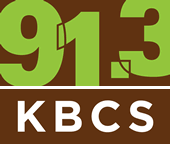The International District’s Fortune Cookie and Noodle Factory
Take a tour of a local fortune cookie and noodle factory with KBCS’s Yuko Kodama and Dawn Nguyen of the Wing Luke Museum of the Asian Pacific American Experience, otherwise known as the Wing. Speaking of food, The Wing offers a tour called the International Dumpling Crawl, now through march, to tour and try dumplings at various restaurants in Seattle’s Chinatown, International District.
Producers: Yuko Kodama Adria McGhee and Jesse Callahan
0:00
91.3 KBCS music and ideas listener supported radio from Bellevue College.
0:06
Next, we take a field trip into a fortune cookie and noodle factory in Seattle’s Chinatown International District. Yuko Kodama goes on a tour of the neighborhood with the Wing Luke Museum’s Dawn Nguyen.
0:19
Oh wow, look at all these fortune cookies. And all these flat ones! Are they called misfortune cookies?
0:26
Misfortune cookies or unfortate cookies. Where we have stepped in is Tsue Chong. Our very own local fortune cookie and noodle factory that’s been here for 100 years now, in the corner of Eighth and King and this is their little shop where you can buy a super fresh fortune cookies, dried noodles, fresh noodles. Everywhere you look there’s all sorts of different kinds. So anytime you crack open a fortune cookie and you’ve got those two roses on your piece of paper, you now know it comes from this place here.
0:26
Oh, it’s made in the international district. What kind of different kinds of noodles are there here?
1:02
We’ve got, I think at one point they’ve had, like, maybe 14 different kinds? We have wonton noodles, egg noodles, dried noodles, wonton wrappers, they’re all packaged here for you to grab super fresh and super cheap too. So sometimes you might find these in other shops but when you come straight to the source, it’s a little bit more of a better deal.
1:26
They have siu mai wrappers, which are kind of like wonton wrappers and they have like a thin kind and a medium kind of thickness ones.
1:38
That’s depending on what you’re making. So if you’re making siu mai, that’s the pork kind of meatballs with the wrappers on the outside, you want a thinner kind of wrapper versus let’s say, doing dumplings, right? Dumplings, you’ll need something a little bit thicker to house all of that, like yummy goodness that you’re going to make.
1:56
So a lot of people might think you know, “there’s only Chinese dumplings.” What are some of the different kinds of dumplings?
2:02
Some of the more surprising dumplings that people find are the Vietnamese ones where you’ve got like things steamed and banana leaves with tapioca and then they’re savory, but they can also be sweet too. So those ones are always a really big surprise. But there’s just a lot of different kinds besides the jiaozi kind that you find and…
2:27
What’s jiaozi?
2:28
Jiaozi is the type of dumpling that kind of looks like an ear, right? That gets crimped on the side. That’s your general like moon shaped, kind of like yoga, right? So jiaozi is more of the Chinese traditional dumpling the story behind it is about like, how in the winter time, people’s ears were getting so cold that they were like cracking. And so this doctor was like, “hey, I’m going to make something that will fix this” and he put in like different kinds of ingredients that would warm the body during the winter times to prevent the whole ear cracking business, so he called them jiaozi because of that, you know that ear shape and then it’s interesting because, you know, these, these foods, they don’t just stay contained in one country. There’s movement. So the dumpling that we know, gyoza right? The Japanese gyoza that’s coming from jiaozi so you can kind of hear it in the linguistics of the food too.
3:28
Oh, jiaozi versus gyoza.
3:31
Yeah!
3:31
That was a tour of a local fortune cookie and noodle factory with KBCS’s Yuko Kodama and Dawn Nguyen of the Wing Luke Museum of the Asian Pacific American Experience, otherwise known as the Wing. Speaking of food, The Wing offers a tour called the International Dumpling Crawl, now through March, to tour and try dumplings at various restaurants in Seattle’s Chinatown, International District.

